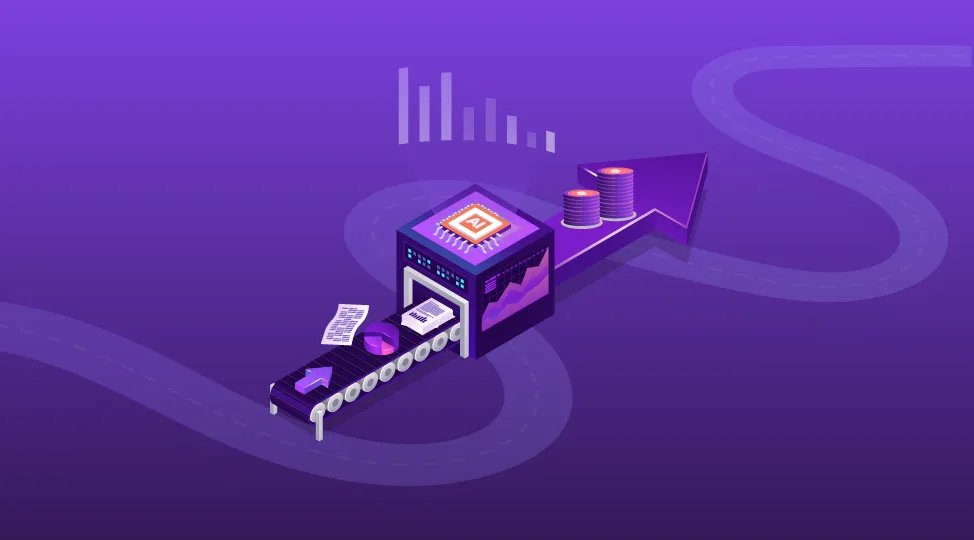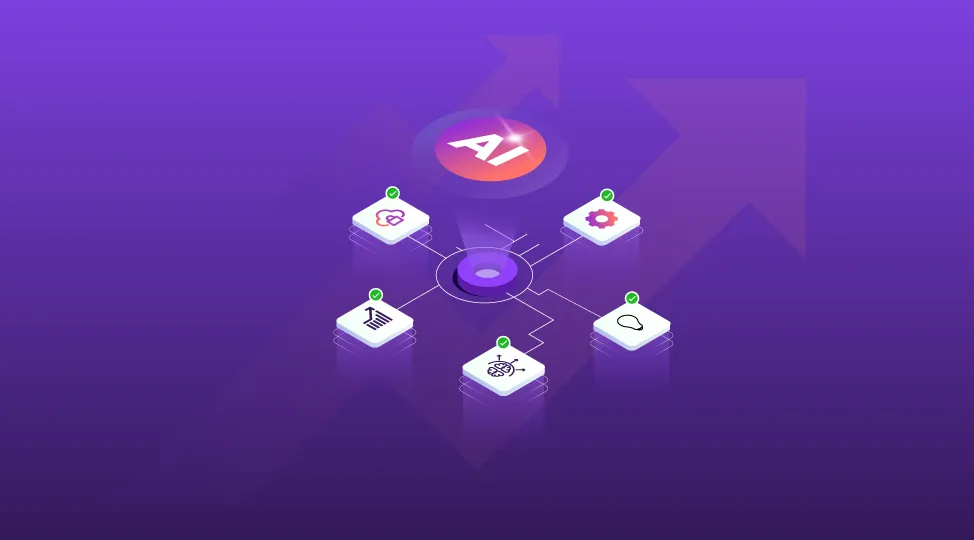Artificial Intelligence

5 min

AI has evolved from a competitive advantage to a boardroom expectation. Yet, beneath the enthusiasm, the results tell a harder truth most AI initiatives still fail to justify their cost.

By Garima Saxena
20 Nov, 2025
According to the 2024 McKinsey Global Survey on AI, only 1% of companies have a fully mature AI strategy, and fewer than 20% measure clear performance outcomes. Despite 78% of organizations already using AI in at least one function, very few translate pilots into profit. The 2025 Stanford AI Index Report echoes this: while AI deployment surged with over 223 new AI medical devices approved by the FDA in 2023 alone , converting innovation into measurable business value remains elusive.
This ROI shortfall isn’t about technology. It’s about the absence of a structured AI adoption roadmap — one that links every investment, model, and algorithm to real business KPIs. The high-profile failure of McDonald’s AI-powered drive-thru program is a textbook example: the system’s technical sophistication collapsed under poor ROI tracking and operational misalignment.
For enterprises, the challenge is no longer about adopting AI but adopting it intelligently. Without a financial lens, even promising models turn into sunk costs. A scattered set of pilots doesn’t equal transformation — it equals confusion.
This article breaks that cycle. You’ll explore a proof-first AI adoption roadmap that transforms experimentation into execution, ensuring AI delivers quantifiable ROI across every department from finance to operations to strategy.
By the end, you’ll know exactly how to:
Because the goal isn’t just to deploy AI, it’s to make every AI decision pay measurable dividends.
Artificial intelligence has reached a paradox. Every boardroom wants it. Every company invests in it. Yet very few can prove that it’s paying off. The failure isn’t in AI itself, it’s in the way organizations adopt AI without a measurable strategy. Many enterprises start with pilot projects fueled by ambition but guided by little more than technical curiosity. The result: isolated experiments, runaway costs, and executives asking, “Where’s the ROI?”
The ROI Disconnect This gap between AI adoption and tangible returns is known as the ROI disconnect — the point where enthusiasm outruns execution. A 2024 MIT study found that nearly 70% of AI pilots never move beyond proof-of-concept, primarily because they track accuracy and automation rates, not profitability metrics such as cost reduction, revenue uplift, or cycle-time improvements.
Let’s break down the core issues:
Most projects begin with a technical question (“Can AI do this?”) rather than a financial one (“How will this improve ROI?”). Without a business anchor, success remains subjective.
Teams celebrate model accuracy while ignoring cost-to-value ratios. AI’s real success isn’t a 92% precision score — it’s how that precision drives a measurable business outcome.
Enterprises often get stuck in pilot purgatory — running multiple small experiments without scaling any. These pilots consume resources but never mature into production-grade systems that impact P&L.
Old systems choke scalability. Add to that employees skeptical of automation, and even the best models fail to gain traction.
AI adoption without executive sponsorship is like navigating without a compass. Without clear ownership, projects drift, funding fades, and results vanish.
A Gartner analysis estimates that $120 billion was spent globally on AI initiatives in 2024, yet over 80% of enterprises failed to quantify their returns. The reason is simple: AI adoption was treated as a technology upgrade, not a business transformation initiative.
A well-designed AI adoption roadmap changes that dynamic. It ensures every initiative — from automation to predictive analytics — is benchmarked against measurable business KPIs.
Instead of chasing “cool use cases,” it prioritizes revenue, efficiency, and scalability — the three pillars that define sustainable ROI.
Every successful AI initiative begins long before the first model is trained or a vendor is chosen. It starts with strategic clarity — defining why the enterprise is investing in AI, what business levers it must move, and how ROI will be proven from day one. A strong foundation ensures that every AI decision is tied to measurable value rather than technical novelty.
Before selecting tools or algorithms, leaders must ask a simple question: “What business problem are we solving, and what does success look like in numbers?” This question turns AI from a cost center into a growth engine.
Use the SMART Framework for ROI-Linked Goals
| Element | Description | Example (Manufacturing Context) |
|---|---|---|
| Specific | Define a clear business objective. | “Reduce machine downtime.” |
| Measurable | Set quantifiable ROI metrics. | “Achieve a 15% decrease in downtime within 6 months.” |
| Achievable | Ensure goals match internal capabilities. | “Leverage existing sensor data for predictive maintenance.” |
| Relevant | Align AI with broader business KPIs. | “Support the company’s goal of improving operational efficiency.” |
| Time-Bound | Commit to a timeline for measurable returns. | “Within two fiscal quarters.” |
An ROI-centric AI adoption roadmap begins when every initiative can be expressed in one sentence:
“We will use AI to achieve [business metric] by [percentage/timeframe], impacting [revenue/cost/satisfaction].”
That statement becomes the anchor for all subsequent investment, governance, and measurement.
AI readiness isn’t just technical maturity; it’s organizational fitness to generate measurable returns. A disciplined readiness audit helps avoid over-spending on pilots that can’t scale.
Poor data leads to poor predictions — and wasted budget.
Ask: Is our data clean, complete, and accessible across departments? High-quality, unified data infrastructure shortens model-training cycles and reduces operational errors that inflate costs.
A lack of skilled AI engineers or data scientists slows delivery, delaying “time-to-value.” Bridging the gap through internal upskilling or partnering with an AI Consulting Service accelerates ROI velocity — the speed at which an AI investment starts generating measurable returns.
Legacy systems often limit AI’s ability to integrate or expand.
Adopting cloud-native, modular architectures ensures scalability and cost predictability. Enterprises that modernize their stack can reduce maintenance costs by up to 25 %.
Even the best model fails if teams resist using it.
Cultural readiness — built through clear communication, executive sponsorship, and change-management programs — can double adoption rates and directly influence ROI outcomes.
With goals and readiness established, the next task is to quantify opportunity versus effort. A practical scoring matrix helps rank potential AI projects by: Business Value → revenue growth, cost reduction, or efficiency gain.
Implementation Feasibility → data availability, system integration complexity, and change readiness.
Example Matrix: Quick-Win Identification
| Priority | Use Case | Business Value | Feasibility | ROI Potential |
|---|---|---|---|---|
| 1 | Predictive maintenance (Manufacturing) | High | High | Immediate ROI (3–6 months) |
| 2 | AI-driven personalization (Retail E-commerce) | High | Medium | Strong ROI (6–9 months) |
| 3 | AI-powered claims processing (Insurance) | Medium | Medium | Moderate ROI (9–12 months) |
| 4 | Conversational AI for HR queries | Low | High | Incremental ROI (12 months+) |
Strategy without proof is speculation. At this stage, your organization has defined its goals, assessed readiness, and prioritized high-impact use cases. The next step is to translate that strategy into a proof-first execution model — one that validates value early, minimizes risk, and creates an evidence trail for ROI. Instead of scaling fast and fixing later, enterprises should scale what’s proven. Each stage of implementation should demonstrate a quantifiable business return before the next investment milestone is unlocked.
Data is not the exhaust of operations; it’s the raw material of ROI. Inaccurate or incomplete data silently drains AI’s financial potential. Every misclassified transaction or duplicate record compounds error across models, distorting insights and decisions.
Practical Imperatives for ROI-Ready Data
Large-scale AI initiatives often fail because they scale unproven assumptions. A proof-of-value (PoV) pilot flips that logic — it’s designed to prove measurable business benefit before full deployment.
Each pilot should be governed by KPI gates — pre-defined checkpoints that determine whether the project continues, pivots, or stops.
Control Framework
| Mechanism | Description | ROI Impact |
|---|---|---|
| KPI Gates | Tie every pilot to quantifiable metrics (cost reduction %, cycle-time improvement, accuracy baseline). | Ensures expansion only for proven value. |
| Budget Stop-Loss | Define budget thresholds; automatically pause or halt pilots exceeding them. | Prevents sunk-cost spirals and enforces discipline. |
| Time-to-Value Targets | Predetermine how fast the pilot must generate visible benefits (typically 60–90 days). | Keeps teams focused on velocity of ROI. |
When executed rigorously, KPI-gated pilots act as internal ROI validators — confirming that each model delivers measurable business impact before more capital is committed.
A successful pilot is proof of potential, not permanence. To achieve consistent, scalable ROI, AI models must be operationalized through Machine Learning Operations (MLOps) — the discipline that automates model lifecycle management. MLOps bridges the gap between data science and enterprise IT. It standardizes deployment, monitoring, retraining, and governance — ensuring that every model in production remains accurate, compliant, and cost-efficient.
MLOps = Predictable ROI
Continuous Monitoring: Automatically track model accuracy and data drift.
Automated Retraining: Trigger retraining workflows when performance dips beyond a set threshold.
Version Control & Audit Trails: Provide transparency for compliance and performance audits.
When embedded into your AI adoption roadmap, MLOps transforms early pilot wins into sustained value. It converts what was once manual and error-prone into a repeatable ROI engine. Organizations leveraging AI Development Services with mature MLOps pipelines report 30 % faster time-to-production and 40 % lower maintenance costs, according to Deloitte’s 2024 AI State Report.
At this stage, your enterprise has: Proven early business value through KPI-gated pilots.
Established a reliable data foundation to secure accuracy.
Embedded MLOps to sustain model performance.
Together, these create an ROI-assured execution loop — every step validated, every outcome measured, every dollar traceable.
Scaling AI isn’t about multiplying models; it’s about multiplying measurable impact. At this stage, your pilots have proven value. The next challenge is institutionalizing that proof — ensuring ROI is tracked, communicated, and sustained as initiatives expand across business units. This requires a closed-loop measurement system — a framework that quantifies success in financial, operational, strategic, and risk dimensions, and uses that data to drive scaling decisions.
Enterprises that measure only technical success (“model accuracy,” “uptime”) fail to see the complete picture.
True ROI emerges when financial outcomes align with operational efficiency, strategic growth, and risk governance.
KPI Layer Framework
| KPI Layer | Focus Area | Example Metrics | ROI Impact |
|---|---|---|---|
| Financial | Direct profitability and cost outcomes | Cost savings, revenue uplift, customer lifetime value | Quantifies tangible monetary gain |
| Operational | Process efficiency and productivity | Cycle-time reduction, automation coverage, throughput per employee | Improves margin and output quality |
| Strategic | Competitive and innovation outcomes | Time-to-market, product innovation rate, market share change | Measures long-term enterprise value |
| Compliance & Risk | Governance, reliability, and resilience | Audit accuracy, regulatory compliance, incident reduction | Protects ROI by preventing loss and penalty |
This layered structure turns AI measurement into an ROI radar — detecting both short-term paybacks and long-term value creation.
Each new AI initiative should define target KPIs in all four layers, benchmark against the current baseline, and report variances quarterly.
Companies using structured KPI frameworks report 2.3× higher enterprise-wide ROI and 35 % shorter scaling cycles (PwC, 2025).
Scaling AI successfully requires financial visibility at every level — from project teams to the C-suite. The simplest way to maintain that visibility is through real-time ROI dashboards.
What to Track
Executive Confidence: Transparent metrics reduce skepticism and accelerate budget approvals.
Funding Discipline: Resources are funneled only toward initiatives exceeding KPI thresholds.
Cultural Shift: When teams see impact data, AI adoption becomes a shared accountability, not an isolated project.
These dashboards should be automated, integrated into existing BI systems, and visible across departments.
A unified ROI command center helps enterprises decide — with data, not intuition — which AI projects deserve scaling.
Scaling isn’t replication; it’s optimization. Once a pilot achieves repeatable ROI, replicate the success pattern — not the code base — across business functions.
By converting PoV wins into enterprise-wide playbooks, organizations create a scaling flywheel — each success funds and informs the next.
Case Example:
A Fortune 500 logistics firm implemented this approach to expand predictive-route optimization.
By linking each expansion to cost-per-delivery KPIs, it reduced logistics overhead by 28 % while improving on-time performance by 34 % across five regions.
Summary: Measurable Scale = Sustainable Advantage
At this stage, your enterprise has matured from experimenting with AI to operating AI as a measurable business function.
You now:
That’s how AI transitions from innovation cost to operational profit center.
The most overlooked part of any AI adoption roadmap isn’t the build — it’s the afterlife.
Once models are deployed and dashboards show returns, the temptation is to move on to the next big use case. That’s when ROI silently erodes.
Sustained ROI requires governance discipline — a structured way to monitor performance, manage risks, and ensure AI systems continue to deliver measurable business value long after launch.
Without governance, today’s asset becomes tomorrow’s liability.
Traditional governance focuses on compliance. ROI-focused governance goes further — it ensures that compliance safeguards financial value rather than just ticking boxes.
Key Pillars of AI Governance
| Pillar | Objective | Business Impact |
|---|---|---|
| Bias & Fairness Management | Detect and mitigate algorithmic bias. | Prevent reputational and legal risks that could erode ROI. |
| Accountability Frameworks | Assign ownership for both technical and financial outcomes. | Ensures accountability for ROI at every operational layer. |
| Data Privacy & Security | Align data handling with regulations (GDPR, HIPAA, etc.). | Avoid fines, maintain stakeholder trust, and protect brand value. |
| Transparency & Explainability | Ensure model decisions are interpretable. | Builds user confidence and supports audit-readiness. |
| Lifecycle Auditing | Continuously monitor model drift, accuracy decay, and system dependencies. | Prevents hidden degradation that impacts ROI. |
An effective governance model makes AI performance a board-level conversation. CFOs see not just compliance checkmarks, but a visible connection between governance and ROI preservation.
According to Accenture’s AI Maturity Index (2025), enterprises with ROI-driven governance models outperform peers by 37 % in sustained AI profitability over three years.
AI ROI isn’t static. It evolves with data, markets, and customer behavior. The companies that retain AI advantage are those that continuously tune their models and business processes to capture new value streams.
Continuous Optimization Checklist
Monitor ROI Decay: Establish quarterly ROI audits. Detect early signs of performance drift or declining returns.
Retrain Proactively: Use MLOps pipelines to automatically retrain models as data patterns shift.
Evaluate New Opportunities: bRegularly score emerging AI technologies (e.g., generative models, agentic AI systems) for potential ROI impact.
Integrate Human Feedback: Combine model learning with real-world insights from employees and customers. This hybrid approach ensures relevance and trust.
Refine KPIs Over Time: As business priorities evolve, recalibrate your KPI frameworks to measure what now defines success.
Sustained optimization is what separates organizations that deploy AI once from those that compound ROI continuously.
Every successful AI project generates insights — on what worked, what failed, and why. Capturing these learnings institutionalizes efficiency.
Best Practice: Create an AI Center of Excellence (CoE) responsible for:
Maintaining governance frameworks.
T- racking enterprise-wide AI ROI.
Standardizing MLOps and compliance processes.
Sharing best practices and toolkits across business units.
By centralizing accountability, the CoE acts as the nerve center of AI-driven value — ensuring governance, optimization, and strategy remain in lockstep.
Enterprises with a dedicated AI CoE realize 25–40 % higher cumulative ROI compared to those with distributed ownership (McKinsey, 2025).
Governance isn’t bureaucracy; it’s ROI insurance. When done right, it prevents model decay, maintains compliance, reduces hidden costs, and builds stakeholder confidence.
By now, your organization has:
This is how AI stops being an expense and becomes a self-improving growth engine.
A successful AI adoption roadmap isn’t defined by how many models you deploy, but by how much measurable value those models create — and continue to create — over time. AI maturity, at its core, is the ability to connect every algorithm to a balance sheet outcome. That’s what differentiates experimentation from transformation — and ambition from accountability.
Real transformation happens when AI shifts from pilots to performance. The following case studies illustrate how enterprises across industries have implemented ROI-centric AI adoption roadmaps to achieve measurable, sustained returns.
Lenovo’s global supply chain relied heavily on manual forecasting models, leading to excess inventory and delayed responses to market demand. The company adopted an AI-powered demand-sensing system trained on multivariate data — including seasonality, regional trends, and sales velocity.
Results:
Lenovo’s success demonstrates how ROI emerges not from isolated AI deployment but from data-driven alignment with core financial metrics.
Amazon’s massive fulfillment network faced operational inefficiencies as order volumes grew. By integrating AI-based route optimization and robotic automation, the company redesigned logistics around measurable KPIs — delivery time, fulfillment cost, and stock accuracy.
Results:
Amazon’s model embodies MLOps-driven ROI scaling, where continuous data monitoring and automation compound returns across business units.
Walmart deployed predictive models to manage perishable goods more intelligently. These models analyzed local buying behavior, weather forecasts, and supply fluctuations to minimize spoilage.
Results:
This case underscores that ROI in AI isn’t just financial — it’s operational and reputational.
The UK’s National Health Service adopted an AI-powered diagnostic system to triage chest X-rays. The goal: reduce radiologist workload and accelerate diagnosis for critical cases.
Results:
The NHS case shows how AI roadmaps designed with governance and KPI gates drive ROI in patient outcomes as well as efficiency metrics — an important benchmark for healthcare enterprises.
Even the most advanced organizations face systemic challenges when operationalizing AI at scale. Recognizing these early prevents ROI erosion and implementation fatigue.
AI projects collapse when strategic objectives aren’t unified across leadership. Without C-level sponsorship and measurable business KPIs, initiatives risk fragmentation and lack of ownership.
Fix: Anchor every AI goal to financial outcomes tied to business-unit leaders.
Inconsistent, siloed data environments destroy model reliability and delay time-to-value.
Fix: Prioritize enterprise data governance. Use data observability tools to monitor lineage and accuracy continuously.
Many organizations lack AI fluency. Technical debt increases when adoption meets internal skepticism.
Fix: Combine training with executive-led change management. Partner with an AI Consulting Service to augment expertise without delaying delivery.
Traditional accounting models fail to capture intangible gains like improved decision velocity or reduced risk exposure.
Fix: Build hybrid ROI models that include both tangible (revenue, cost) and intangible (efficiency, accuracy) metrics.
AI solutions handling sensitive data must comply with evolving global regulations — GDPR, HIPAA, and emerging AI Act frameworks.
Fix: Integrate compliance KPIs into your governance layer. This turns regulatory adherence into a measurable ROI safeguard, not an afterthought.
Enterprises often confuse “scaling” with “copying.” Scaling AI without contextualization causes performance drop-offs.
Fix: Adopt the portfolio approach — only scale use cases that maintain ROI thresholds and pass KPI audits for two consecutive quarters.
Track both financial (cost reduction, revenue growth) and operational metrics (cycle-time reduction, error rate improvement).
Add customer-centric KPIs like Net Promoter Score (NPS) to quantify experience-driven value.
Use: ROI = (Net Benefits − Total Costs) ÷ Total Costs
This functional granularity gives a complete ROI picture.
Most organizations begin to see measurable ROI within 6–12 months of deployment. Quick-win projects — such as automation or demand prediction — can show returns even faster when KPI gates are in place.
Use proxy metrics — for example, faster decision cycles, improved forecast accuracy, or customer retention uplift. Convert these into monetary equivalents over time to quantify their contribution to ROI.
Partnering with an experienced AI Development Company shortens time-to-value. It brings proven frameworks, MLOps pipelines, and governance systems that reduce risk and cost overruns while accelerating measurable outcomes.
The organizations winning with AI in 2025 aren’t necessarily those with the most models — they’re the ones that measure what matters.
A disciplined AI adoption roadmap converts innovation into profit, experimentation into process, and insight into sustainable competitive edge.
When every stage — from strategy to governance — is tied to a measurable financial outcome, AI stops being a buzzword and becomes a balance sheet multiplier.
Generative AI Implementation Strategy: From Concept to Deployment (Step-by-Step Guide)
By Sannidhya Sharma
5 min read
How to Design a Web App: From Wireframes to Working Prototype
By Dhruv Joshi
5 min read
How Much Does Generative AI Development Cost in 2026?
By Dhruv Joshi
5 min read
How to Build an AI Adoption Roadmap That Ensures Measurable ROI
By Garima Saxena
5 min read

Artificial Intelligence

5 min
Generative AI only works at scale when you follow a clear strategy, not scattered experiments. This blog walks through a structured Generative AI implementation roadmap—from use case ideation and data prep to model selection, deployment, and ongoing monitoring—while highlighting common pitfalls and how AI consultancy / generative AI development services can speed up a successful, ROI-focused AI product launch.


Artificial Intelligence

5 min
Clear guidance to budget Generative AI in 2026: small pilots cost ~$20k–$60k, mid-size apps ~$60k–$250k+, enterprise programs ~$400k–$1M+. Costs hinge on scope, model choice, data work, integrations, and operations. Use a line-item plan and a simple estimator to forecast build and run-rate. Start with an MVP, track tokens, plan MLOps, and phase delivery. Control security, monitor drift, align to KPIs.


Artificial Intelligence

7 min
AI development costs in 2026 range from $10K–$50K for simple tools to $1M+ for enterprise systems. Factors like data quality, complexity, and cloud infrastructure shape pricing. Start with a Minimum Viable AI (MVAI), use pre-trained models, and budget 15–20% annually for maintenance. The goal isn’t just saving cost—it’s maximizing ROI with scalable AI.


Feeling lost!! Book a slot and get answers to all your industry-relevant doubts